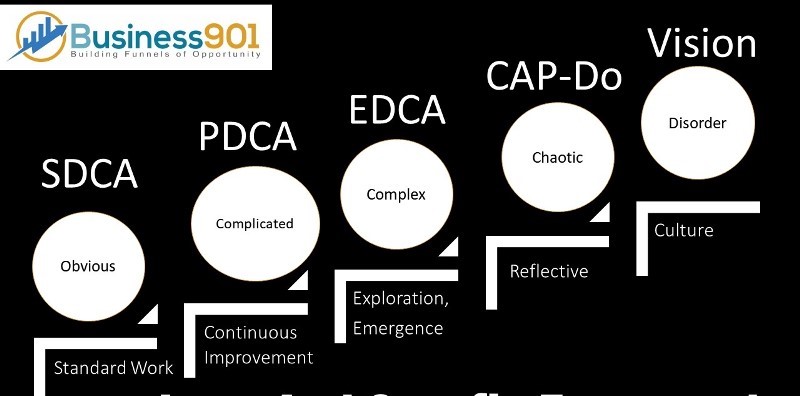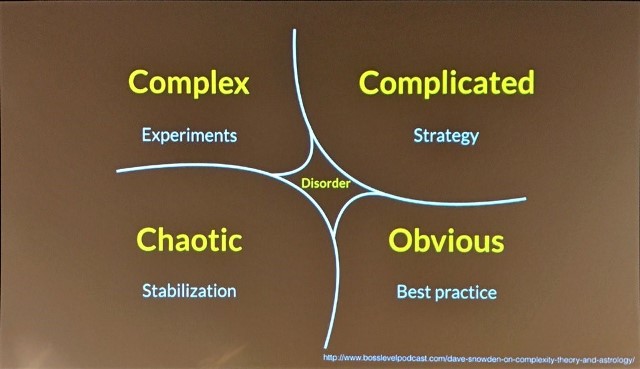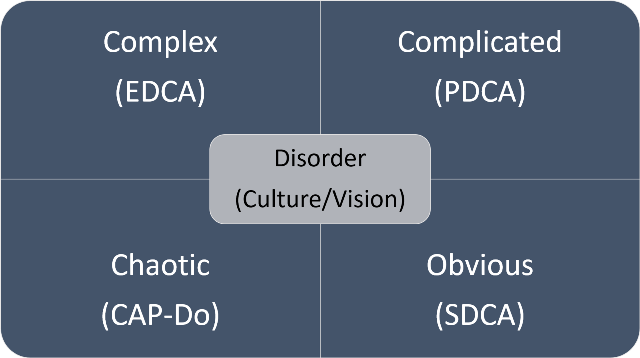I have been a Dave Snowden fan for years. His company Cognitive Edge is a great resource, especially for learning the Cynefin Framework. A not so quick introduction is contained in this embedded video on my blog, Dave Snowden’s Talk on Cynefin at LeanWX. Below is the latest, diagram that I believe Mr. Snowden is using to describe the framework. The Cynefin framework is a conceptual framework used to help managers, policy-makers, and others reach decisions. A quick overview:
- The Obvious domain (known to knowns) is characterized by stability and cause and effect relationships.
- The Complicated domain (known to unknowns) is characterized by the clear relationship between cause and effect, but it is not obvious to everyone.
- The Complex domain (unknown to unknowns) is characterized by the actions of sense analyze, and respond or adaptive type thinking.
- The Chaotic domain (unknowables) is characterized by a leader having to act first to establish order and transform the situation to one of the lower domains.
- The fifth domain of Disorder applies to when you are not sure which of the other domains you are in or how to characterize it.
If you have ever been in a group of Agile or Design Thinkers, most will hang their hat on the Cynefin framework and that Lean cannot handle complexity, let alone the chaotic domain. They, in fact, will argue that only Agile can handle this. They will go back and say automobile manufacturing is not complex. I do not want to argue that point, I will say that if you think automobile manufacturing is not complex, you have not been in an automobile factory in quite a while. This is not my argument though. The basic format of Lean Thinking handles all the domains of Cynefin without any modifications, no new fangled methods or some other processes. It is sort of like Dorothy in the Wizard of Oz, just tap your shoes, the power has been there all along. This diagram matches the Five domains of Cynefin with the Lean Thinking Process. The Lean Thinking process as I use it:
I like to start with the idea of CAP-Do. When I create an A3 from CAP-Do, I call it the Reflection A3. CAP-Do was a process popularized by Scholtes, Joiner, and Ikao especially Ikao in his Hoshin work. Utilizing CAP-Do, we start with Check – an internal reflection. Adjust is a key during this cycle. It is used to establish a starting point for the other iterations of EDCA-PDCA-SDCA. A starting point and an evaluation point. It is not tactical in nature. We move from Chaos Domain (CAP-Do) breaking the problem into the appropriate domains for execution: SDCA-PDCA-EDCA..
EDCA is a term I learned from Graham Hill to designate the Explore aspect of Lean. I view it as the sense, analyze and respond aspect of Lean. This is one of the most confusing aspects when comparing Lean to Agile. The idea of exploration sensing and responding, as Mike Rother calls it working as far as the flashlight can see. It is a learning activity and often measured by what we have left to learn.
Applying PDCA, allows us to “see” opportunities for improvement. A Continuous Improvement Culture (Kaizen) catalyzes the creation of stimulating habitats, leveraging the resources in our environment.
SDCA: Standard Work creates a CAN-DO attitude and frees up time to spark problem-solving.
I like to review the process outside of a quadrant and displayed in a staircase fashion.
What about the disorder? The disorder is defined by the culture, and that is where I think Lean trumps Agile. The little “i” provided through SDCA and PDCA defined as the Lean Culture will stimulate the knowledge, imagination, and attitude to create something from nothing. This prepares us, so we can now tackle the big “I” of Innovation, EDCA. These habitats, along with attitude, influence the culture in an organization. It creates that Kaizen Spirit that points us to our vision and helps create order from the disorder. Simply, because we know the direction we are going.




